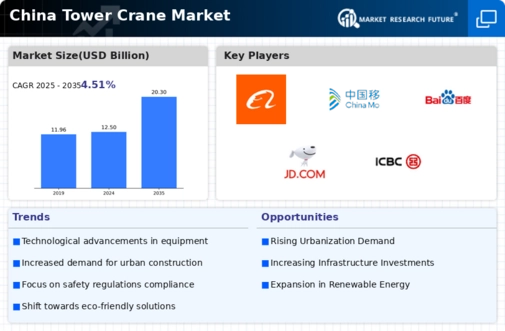The tower crane market in China is characterized by a dynamic competitive landscape, driven by rapid urbanization and infrastructure development. Key players such as Zoomlion (CN), SANY (CN), and Liebherr (DE) are at the forefront, each adopting distinct strategies to enhance their market presence. Zoomlion (CN) focuses on innovation and technological advancements, particularly in smart crane solutions, while SANY (CN) emphasizes regional expansion and local manufacturing to cater to domestic demand. Liebherr (DE), on the other hand, leverages its global expertise to introduce high-quality products tailored to the Chinese market, thereby enhancing its competitive edge. Collectively, these strategies contribute to a moderately fragmented market structure, where competition is intensifying as companies seek to differentiate themselves through advanced technology and localized services.
In terms of business tactics, companies are increasingly localizing manufacturing and optimizing supply chains to reduce costs and improve efficiency. This approach not only enhances responsiveness to market demands but also aligns with the broader trend of sustainability, as firms aim to minimize their carbon footprints. The competitive structure remains moderately fragmented, with several players vying for market share, yet the influence of major companies is palpable, shaping industry standards and customer expectations.
In October 2025, Zoomlion (CN) announced the launch of its latest series of smart tower cranes, integrating AI technology to enhance operational efficiency and safety. This strategic move underscores the company's commitment to innovation and positions it favorably in a market that increasingly values technological advancements. By incorporating AI, Zoomlion (CN) aims to streamline construction processes, potentially reducing project timelines and costs, which could significantly impact its competitive standing.
In September 2025, SANY (CN) expanded its manufacturing capabilities by opening a new facility in Jiangsu province, aimed at increasing production capacity for tower cranes. This expansion is strategically important as it not only meets the growing domestic demand but also enhances SANY's ability to respond swiftly to market fluctuations. The facility is expected to employ advanced manufacturing techniques, further solidifying SANY's reputation for quality and reliability in the market.
In August 2025, Liebherr (DE) entered into a strategic partnership with a leading Chinese construction firm to co-develop innovative tower crane solutions tailored for large-scale urban projects. This collaboration is indicative of Liebherr's strategy to leverage local expertise while enhancing its product offerings. By aligning with a prominent player in the Chinese market, Liebherr (DE) is likely to gain valuable insights into customer preferences and operational challenges, thereby strengthening its competitive position.
As of November 2025, the competitive trends in the tower crane market are increasingly defined by digitalization, sustainability, and the integration of AI technologies. Strategic alliances are becoming more prevalent, as companies recognize the value of collaboration in driving innovation and enhancing market reach. Looking ahead, competitive differentiation is expected to evolve, shifting from traditional price-based competition to a focus on technological innovation, supply chain reliability, and sustainable practices. This transition may redefine the competitive landscape, compelling companies to invest in R&D and forge strategic partnerships to maintain their market positions.
















Leave a Comment